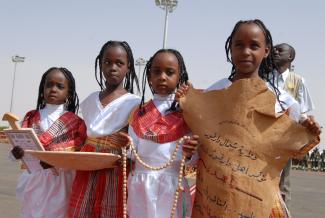USAID has responded to humanitarian crises in Sudan dating back to the 1980s, including major droughts and floods, food insecurity and famine, and conflict-related displacement.
Escalation of conflict since 2014 and a significant increase in the number of displaced populations, among other factors, has led to a rise in the number of people who need humanitarian assistance in Sudan to an estimated 5.8 million people.
USAID’s current priorities include providing life-saving assistance to conflict-affected populations in the Darfur region, South Kordofan and Blue Nile. USAID’s Rapid Response Fund—managed by the International Organization for Migration—provides short-term funding to national and international relief agencies responding to acute needs and rapid onset crises in Sudan.
In fiscal year (FY) 2016, USAID provided more than $54 million in non-food humanitarian assistance to Sudan for activities including water, sanitation, and hygiene; health; nutrition; shelter; protection; agriculture and food security; economic recovery and market systems; as well as humanitarian coordination and information management, logistics support and the provision of relief commodities such as emergency shelters, cooking sets and hygiene kits.
FOOD ASSISTANCE
Through USAID, the United States Government has consistently been the largest donor of food assistance to Sudan. In FY 2016, USAID provided more than $164 million to the United Nations World Food Program (WFP) and UNICEF to support food-insecure and vulnerable populations through the distribution of emergency food aid, including ready-to-use supplementary and therapeutic foods, to help critically malnourished children regain their health. In addition to direct food aid, USAID’s contribution in FY 2016 included $10 million to WFP for voucher programs that enable people in need of food assistance to purchase Sudan-grown food commodities, and $1.4 million to UNICEF for local purchase of specialized nutrition products. Since 2004, those affected by conflict in Darfur have comprised the majority of Sudan’s food aid beneficiaries.
CONFLICT MITIGATION AND PREVENTION
USAID aims to support and strengthen local communities’ ability to address the causes and consequences of local and political conflict, violence and instability. USAID also supports key reconciliation processes to mitigate potentially catalytic conflicts. USAID’s peace and reconciliation programs are currently active in Blue Nile, West Kordofan, South Kordofan, the Darfur region and the Abyei Area, a disputed area on the Sudan-South Sudan border. USAID also works with youth and women’s groups in Sudan to reduce vulnerabilities to conflict, build leadership skills to foster peacebuilding, improve livelihoods and help create the enabling conditions for development.

AECOM International Sudan
